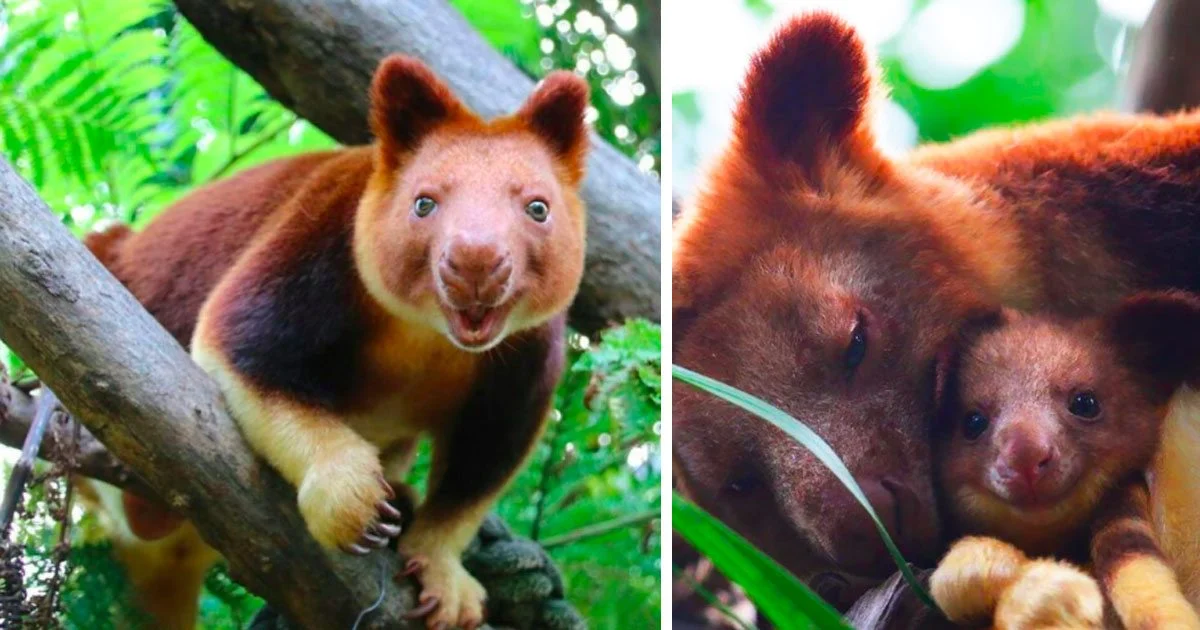Have you ever imagined a kangaroo that climbs trees? It might sound like something from a storybook, but high in the rainforests of Australia and New Guinea lives a truly remarkable animal that does just that. Meet the tree kangaroo, a fascinating creature that traded a life on the ground for a home among the leaves. These shy, unique marsupials are a wonderful example of how animals adapt to their environment in surprising ways. Get ready to explore the world of this amazing treetop dweller.
Key Takeaways
- A tree kangaroo is a type of macropod that is adapted to living in trees, unlike its ground-dwelling relatives.
- They are primarily found in the tropical rainforests of northeastern Queensland, Australia, and the island of New Guinea.
- These animals have powerful forelimbs for climbing and a long, non-prehensile tail used for balance.
- Most tree kangaroo species are endangered due to habitat loss and hunting.
- Conservation efforts are crucial to protect these unique marsupials and their fragile rainforest homes.
What Exactly is a Tree Kangaroo?
A tree kangaroo belongs to the Dendrolagus genus and is a type of macropod, which means “big foot.” This is the same family that includes kangaroos and wallabies. However, while its cousins evolved for life on the open plains, the tree kangaroo went in a completely different direction—up! Scientists believe their ancestors were possum-like creatures that came down from the trees and then, millions of years later, some of their descendants decided to go back up. This evolutionary journey has given them a unique set of skills and physical traits that set them apart. They are clumsy on the ground, moving with a slow hop or a walking gait, but in the trees, they are surprisingly agile navigators, leaping from branch to branch with incredible balance.
Where in the World Can You Find Them?
The home of the tree kangaroo is split between two main locations: the lush, tropical rainforests of northeastern Australia and the diverse, mountainous jungles of New Guinea. These specific habitats provide everything they need to survive, from the right kinds of leaves to eat to the tall trees that offer safety from predators.
The Australian Species
In Australia, the tree kangaroo is found exclusively in the Wet Tropics of Queensland. This region is a World Heritage site known for its ancient rainforests. Two species call this area home: the Lumholtz’s tree kangaroo and the Bennett’s tree kangaroo. They prefer the cool, high-altitude forests where they can spend their days hidden in the canopy. Finding one is a rare treat, as they are masters of camouflage and are mostly active at dawn and dusk.
The New Guinea Species
The island of New Guinea, which is divided between Papua New Guinea and Indonesia, is the true heartland of tree kangaroo diversity. At least a dozen different species live here, each adapted to a specific mountain range or forest type. Species like the Matschie’s tree kangaroo, with its striking golden fur, and the Goodfellow’s tree kangaroo, known for its beautiful stripes, inhabit these remote and rugged landscapes. The sheer variety here highlights how these animals have evolved in isolation, much like the unique tribal art found in the region, which you can explore at platforms like Ancient Artz.
Unique Adaptations for a Life in the Trees
To live successfully in the treetops, the tree kangaroo has developed some incredible physical features that distinguish it from its ground-dwelling relatives. These adaptations are a perfect example of evolution in action.
Powerful Limbs and Claws
Unlike a ground kangaroo’s short front legs, a tree kangaroo has long, muscular forelimbs that are nearly the same length as its hind legs. This gives it the strength needed to pull itself up tree trunks and move along branches. Its paws are fitted with long, curved claws that provide a secure grip on bark. The pads on its feet are also large and spongy, acting like non-slip grips, which are essential when navigating wet, mossy branches high above the forest floor.
The Balancing Act of the Tail
The tail of a tree kangaroo is another one of its most important tools. It is very long and often has a thick plume of fur, but it’s not prehensile like a monkey’s tail. This means it cannot be used to grip branches. Instead, the animal uses its tail like a rudder or a counterbalance. When it leaps between trees—sometimes across gaps of up to 9 meters (30 feet)—it holds its tail straight out behind it to maintain stability and steer its landing. On the ground, it keeps its tail curved upward to help with its awkward hopping.
What Do Tree Kangaroos Eat?
A tree kangaroo is primarily a folivore, which means its diet consists mainly of leaves. They are quite selective, often preferring the leaves of specific trees and vines found in their rainforest home. They have a complex stomach, similar to a cow’s, which helps them break down the tough cellulose in leaves. This digestive process takes a long time, which is one reason they spend a lot of their day resting and digesting their meals. Besides leaves, they will also eat fruits, flowers, ferns, and even bark when their favorite foods are scarce. This varied diet helps them get all the nutrients they need to survive in their challenging environment.
The Life Cycle and Behavior of a Tree Kangaroo
The tree kangaroo is a solitary and often nocturnal or crepuscular animal, meaning it is most active at night or during the twilight hours of dawn and dusk. This behavior helps them avoid daytime predators and the heat.
A Solitary Existence
Adults generally live alone, with males defending a territory that may overlap with the territories of several females. They communicate through scents and occasional vocalizations. They are not aggressive animals and will usually try to flee if they feel threatened. Much of their day is spent sleeping, curled up on a high branch or in the fork of a tree, hidden from sight. This reclusive nature makes them very difficult to study in the wild, and much of what we know comes from observing them in conservation centers.
Raising Their Young
Like all marsupials, a female tree kangaroo gives birth to a tiny, underdeveloped baby called a joey. The joey is usually no bigger than a jellybean at birth. Immediately after birth, this tiny creature must make the difficult journey from the birth canal to its mother’s pouch, all on its own. Once inside the pouch, it attaches to a teat and will stay there for several months, growing and developing in safety. The joey will begin to peek out of the pouch at around six months and will start to explore the outside world, climbing on its mother’s back, a few months after that. It will remain dependent on its mother for over a year, learning the essential skills for survival in the trees.
Species of Tree Kangaroo at a Glance
There are at least 14 recognized species of tree kangaroo. Each one is unique, though they all share the fundamental tree-climbing lifestyle. Here’s a look at a few of them.
| Species Name | Common Name | Location | Conservation Status |
|---|---|---|---|
| Dendrolagus matschiei | Matschie’s Tree Kangaroo | Huon Peninsula, PNG | Endangered |
| Dendrolagus lumholtzi | Lumholtz’s Tree Kangaroo | Queensland, Australia | Near Threatened |
| Dendrolagus bennettianus | Bennett’s Tree Kangaroo | Queensland, Australia | Near Threatened |
| Dendrolagus goodfellowi | Goodfellow’s Tree Kangaroo | Central New Guinea | Endangered |
| Dendrolagus scottae | Tenkile (Scott’s) | Torricelli Mtns, PNG | Critically Endangered |
| Dendrolagus dorianus | Doria’s Tree Kangaroo | Western New Guinea | Vulnerable |
Threats to Survival
Sadly, almost every species of tree kangaroo is facing threats that are pushing them closer to extinction. Their survival is closely linked to the health of their rainforest homes, which are disappearing at an alarming rate.
Habitat Loss and Fragmentation
The biggest threat to the tree kangaroo is habitat destruction. Deforestation for agriculture, logging, mining, and human settlement destroys the forests they depend on for food and shelter. As forests are cleared, their habitat becomes fragmented, creating isolated patches of forest. This makes it difficult for a tree kangaroo to find mates and food, and it increases their vulnerability to predators when they are forced to travel across open ground.
The Impact of Hunting
In New Guinea, the tree kangaroo has been a traditional source of food for local communities for thousands of years. While sustainable hunting by indigenous populations has occurred for centuries, the introduction of modern weapons and growing human populations has led to over-hunting in many areas. This pressure, combined with habitat loss, has had a devastating impact on many species, especially larger ones like the Tenkile, which is now critically endangered.
Conservation Efforts: A Glimmer of Hope
Despite the many threats, dedicated people and organizations are working hard to protect the tree kangaroo and its habitat. Conservation efforts involve a combination of scientific research, community engagement, and habitat protection.
- Protected Areas: Creating national parks and protected reserves is one of the most effective ways to safeguard large areas of rainforest from being cleared.
- Community-Based Conservation: In New Guinea, organizations like the Tree Kangaroo Conservation Program are working with local communities. They help villagers find sustainable sources of income that don’t rely on deforestation or hunting, empowering them to become guardians of the forest and the tree kangaroo.
- Captive Breeding Programs: Zoos and conservation centers around the world are running captive breeding programs. These programs serve as a safety net for the most endangered species, maintaining a healthy genetic population that could one day be used to reintroduce animals back into protected areas in the wild.
- Research and Monitoring: Scientists are using tools like camera traps and GPS collars to learn more about the behavior and needs of the elusive tree kangaroo. This information is vital for developing effective conservation strategies.
Conclusion
The tree kangaroo is more than just a biological curiosity; it is a symbol of the incredible diversity of life found in our planet’s rainforests and a reminder of how fragile these ecosystems are. From its powerful climbing arms to its long balancing tail, every part of this animal tells a story of adaptation and survival. As their forest homes continue to shrink, the future of the tree kangaroo depends entirely on our actions. By supporting conservation efforts and raising awareness, we can help ensure that these magnificent treetop marsupials continue to leap through the canopy for generations to come.
Frequently Asked Questions (FAQ)
Q1: Can a tree kangaroo jump like a regular kangaroo?
A1: Yes, but not as well. On the ground, a tree kangaroo moves with a clumsy hop. In the trees, however, they are impressive jumpers, capable of leaping up to 9 meters (30 feet) from one tree to another.
Q2: Are tree kangaroos dangerous to humans?
A2: No, they are very shy and reclusive animals. They will almost always flee if they encounter a human. A cornered or threatened tree kangaroo could potentially scratch with its sharp claws, but they are not considered dangerous.
Q3: How many babies does a tree kangaroo have at once?
A3: A female tree kangaroo typically gives birth to a single joey at a time. This allows her to invest all her energy into raising that one offspring, which has a long period of dependency.
Q4: Why are so many tree kangaroo species found in New Guinea?
A4: New Guinea’s rugged, mountainous terrain has created many isolated habitats. Over millions of years, tree kangaroo populations in these different areas evolved independently, leading to the development of many distinct species, a process known as speciation.









